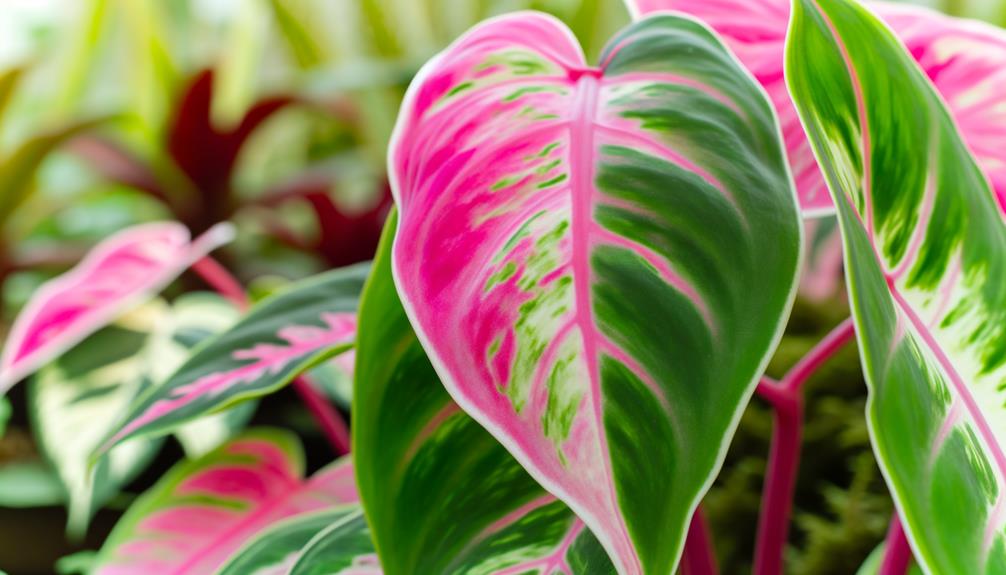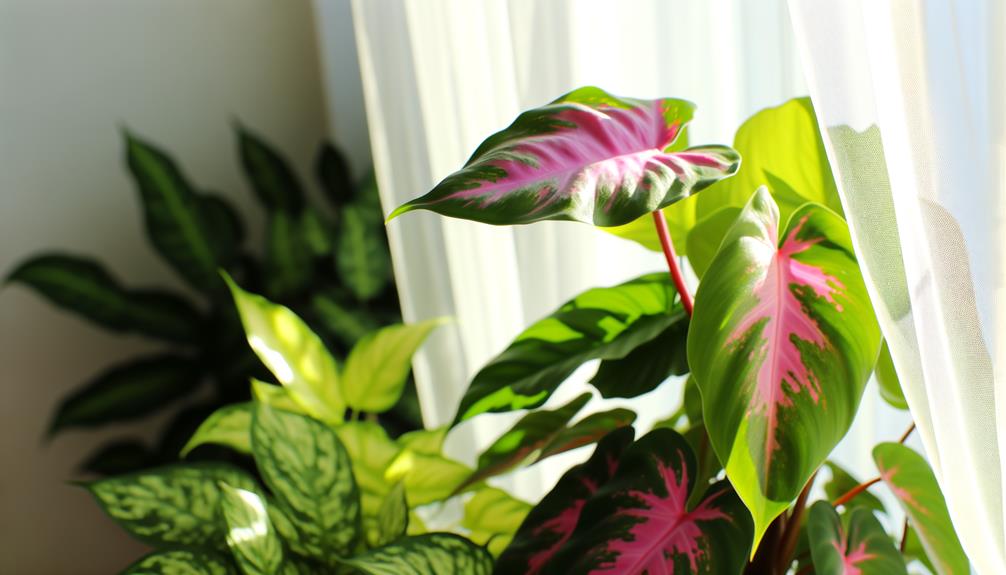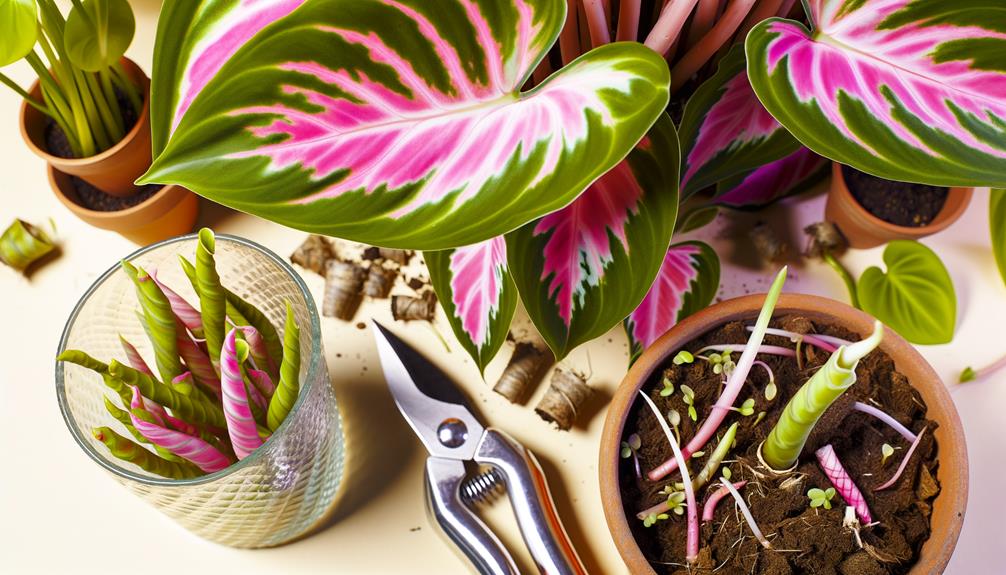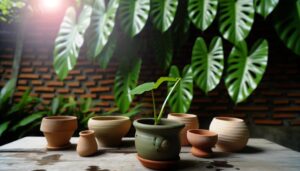What Are the Characteristics of Philodendron Pink Princess Tricolor?
Philodendron Pink Princess Tricolor, highly esteemed in horticulture, features triangulated variegation in pink, green, and white on heart-shaped, glossy leaves. This plant exhibits a climbing or trailing growth habit, reaching 1-2 meters indoors.
Pink variegation results from anthocyanins, while green and white sections are due to chlorophyll and pigmentation absence, respectively. Best growth requires bright, indirect light and well-draining soil to maintain moisture without waterlogging.
It thrives in 18-27°C temperatures with consistent humidity. Propagation occurs via stem cuttings, air layering, or tissue culture.
For meticulous cultivation practices and plant health insights, one can explore further.

Key Takeaways
- Distinct pink, green, and white variegation on heart-shaped, glossy leaves.
- Climbing or trailing growth habit with aerial roots for vertical development.
- Thrives in bright, indirect light; direct sunlight should be avoided.
- Requires a fast-draining soil mix with good aeration, including potting soil, perlite, and orchid bark.
- Ideal temperature range is 18°C to 27°C with consistent humidity levels.
Leaf Coloration

The leaf coloration of the Philodendron Pink Princess Tricolor is characterized by a striking variation of green, pink, and white hues, resulting from genetic variegation. This phenotypic expression is attributed to the differential distribution of chlorophyll and other pigments within the leaf tissue.
Chlorophyll dominates the green sections, while anthocyanins impart the distinctive pink regions. The white areas lack pigmentation, indicating a deficiency in chlorophyll production. This variegation is not uniform, producing a unique pattern on each leaf.
The irregularity in pigment distribution is influenced by environmental factors such as light intensity and nutrient availability. The contrasting colors not only enhance the aesthetic appeal but also signify the plant's complex genetic makeup, underscoring the intricate interplay between genetics and environmental conditions.
Growth Habit
Beyond the distinctive leaf coloration, the growth habit of the Philodendron Pink Princess Tricolor further exemplifies its unique botanical characteristics.
This plant exhibits a vining and climbing growth pattern, facilitated by its aerial roots. These roots anchor the plant to various structures, enabling vertical development. The internodal spacing is moderate, supporting a balanced distribution of leaves along the stem.
This philodendron demonstrates indeterminate growth, meaning it continues to grow as long as environmental conditions are favorable. Additionally, its robust stem structure supports the weight of its variegated foliage, preventing sagging.
The overall morphology is compact yet expansive, making it suitable for both confined indoor spaces and more extensive setups, such as trellises or moss poles.
Light Requirements

The Philodendron Pink Princess Tricolor thrives in bright, indirect light, where the variegation of its leaves can be best expressed.
Prolonged exposure to direct sunlight should be avoided, as it can lead to leaf burn and degradation of the plant's vibrant colors.
Ensuring sufficient yet diffused illumination is essential for maintaining its aesthetic and physiological health.
Optimal Light Conditions
In order to thrive, the Philodendron Pink Princess Tricolor requires bright, indirect light to maintain its vibrant foliage. This specific light condition is essential for several reasons:
- Photosynthetic Efficiency: Adequate indirect light enhances photosynthetic processes, promoting robust growth.
- Color Retention: Sufficient light guarantees the preservation of the plant's unique tricolor variegation, preventing the fading of its distinctive pink hues.
- Leaf Health: Optimal light conditions contribute to the overall health and vitality of the leaves, reducing the risk of chlorosis.
- Growth Rate: Consistent exposure to bright, indirect light can accelerate the plant's growth rate, leading to a fuller, more aesthetically pleasing specimen.
Understanding these factors is vital for maximizing the ornamental value of the Philodendron Pink Princess Tricolor.
Avoid Direct Sunlight
Direct sunlight can cause photodamage to the delicate leaves of the Philodendron Pink Princess Tricolor, leading to scorch marks and reduced variegation. This phenotypic response is indicative of the plant's sensitivity to high-intensity light.
Photoinhibition may occur, impairing photosynthetic efficiency and stunting growth. Ideal light conditions for this species involve bright, indirect light that mimics its natural understory habitat.
Shielding the plant from direct solar radiation can be achieved by positioning it near east or north-facing windows or utilizing sheer curtains to diffuse sunlight. Consistent exposure to filtered light ensures the vivid pigmentation of the leaves is maintained, promoting robust growth and aesthetic appeal.
Regular monitoring and adjusting light exposure are crucial for optimal plant health.
Watering Needs
Ideal hydration for the Philodendron Pink Princess Tricolor requires a balance between maintaining soil moisture and preventing waterlogged conditions. Adopting a precise watering schedule is necessary for its health.
Observations indicate:
- Soil Moisture Consistency: Maintain evenly damp soil, avoiding both dryness and excess saturation.
- Drainage Necessity: Utilize well-draining potting mix to facilitate proper water flow and prevent root rot.
- Watering Frequency: Water approximately once a week, adjusting based on seasonal changes and indoor humidity levels.
- Humidity Considerations: Increase ambient humidity through misting or using a humidifier, particularly in arid environments.
Careful monitoring ensures the plant's best hydration state, facilitating strong growth and colorful foliage. Understanding these parameters is important in maintaining the Philodendron Pink Princess Tricolor's vitality.
Temperature Tolerance

Temperature tolerance in Philodendron Pink Princess Tricolor is essential for best growth and health. The ideal temperature range for this plant lies between 18°C and 27°C, where it thrives best.
Exposure to temperatures outside this range can result in physiological stress, necessitating specific seasonal care adjustments to mitigate potential damage.
Ideal Temperature Range
Thriving efficiently in a temperature range of 65-80°F (18-27°C), the Philodendron Pink Princess Tricolor demonstrates a preference for consistently warm and stable environmental conditions. Maintaining such temperatures promotes healthy growth and vibrant foliage.
Key observations for ideal temperature maintenance include:
- Consistent Temperatures: Avoidance of significant temperature fluctuations to prevent stress on the plant.
- Humidity Management: A higher humidity level complements warmer temperatures, enhancing plant vitality.
- Indoor Placement: Positioning the plant away from cold drafts and heat sources maintains the desired temperature range.
- Monitoring Devices: Utilizing thermometers and hygrometers aids in maintaining ideal growing conditions.
These practices underscore the importance of a controlled environment for the Philodendron Pink Princess Tricolor's thriving growth.
Effects of Temperature Extremes
While maintaining ideal temperature ranges is crucial, understanding the effects of temperature extremes on the Philodendron Pink Princess Tricolor is equally important for ensuring its long-term health and resilience.
Exposure to temperatures below 55°F (13°C) can induce chilling injury, manifesting as blackened leaves and stunted growth. Conversely, temperatures exceeding 85°F (29°C) may lead to heat stress, causing leaf wilting, chlorosis, and diminished photosynthetic efficiency. Prolonged exposure to such extremes can compromise cellular integrity, resulting in irreversible damage.
Therefore, monitoring and mitigating temperature fluctuations are essential to maintain physiological homeostasis. Employing environmental controls, such as thermostatic heating or cooling systems, can aid in preserving the best-suited microclimate, thereby promoting robust development and vibrant foliage in this delicate cultivar.
Seasonal Care Tips
To achieve peak growth throughout the year, it is essential to adjust care practices according to seasonal temperature variations for the Philodendron Pink Princess Tricolor. This species thrives in a stable environment where temperature fluctuations are minimized. Ensuring best growth necessitates attention to the following:
- Temperature Range: Maintain an ideal temperature between 65°F and 80°F (18°C to 27°C) during warmer months.
- Winter Care: During winter, avoid temperatures below 55°F (13°C) to prevent cold stress and potential leaf damage.
- Humidity Control: Increased humidity is beneficial; use humidifiers or pebble trays during dry seasons.
- Air Circulation: Proper air circulation is essential to prevent fungal infections, especially in humid environments.
Soil Preferences
Philodendron Pink Princess Tricolor requires a well-ventilated, fast-draining soil mix that retains moisture without becoming waterlogged. An ideal medium typically comprises a blend of potting soil, perlite, and orchid bark to guarantee proper aeration.
The inclusion of sphagnum moss enhances moisture retention while preventing root rot. This substrate composition facilitates a perfect balance of air and water, crucial for root respiration and nutrient uptake. Additionally, incorporating activated charcoal aids in maintaining soil purity by adsorbing toxins.
Regular monitoring of soil pH, ideally between 5.5 and 6.5, ensures nutrient availability and optimal growth conditions. Adequate soil structure supports robust root development, essential for the overall health and aesthetic appeal of the Philodendron Pink Princess Tricolor.
Propagation Methods

Successfully spreading the Philodendron Pink Princess Tricolor involves precise methods such as stem cuttings, air layering, and tissue culture to guarantee genetic consistency and peak growth. Each method has distinct advantages and requires precise execution to support successful spreading and robust plant development.
- Stem Cuttings: Choose a healthy stem with at least one node and aerial root. Place the cutting in water or moist soil to promote root formation.
- Air Layering: Create a wound on the stem, apply rooting hormone, and wrap with moist sphagnum moss until roots form.
- Tissue Culture: Use sterile laboratory conditions to propagate plants from small tissue samples, ensuring genetic uniformity.
- Environmental Conditions: Maintain ideal humidity, light, and temperature to support new growth post-spreading.
Understanding and mastering these techniques are crucial for successful cultivation.
Conclusion
The Philodendron Pink Princess Tricolor, with its variegated foliage, thrives under specific conditions. Its leaves, a tapestry of colors, require moderate light and consistent moisture for best growth. Warm temperatures and well-draining soil further enhance its development.
Propagation, typically through stem cuttings, ensures the continuation of its unique genetic makeup. This botanical marvel, akin to a living canvas, demands precise care to maintain its vibrant hues and robust health, emphasizing the delicate balance between environmental factors and plant importance.






